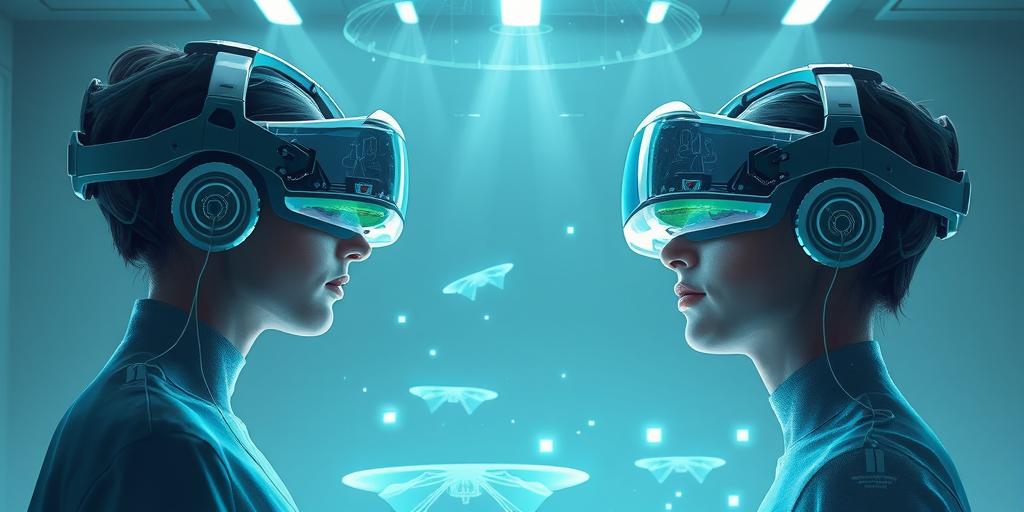Prepare to be amazed! The world of augmented reality (AR) and virtual reality (VR) is on the cusp of a monumental shift, expanding far beyond the gaming consoles and headsets we’ve come to associate with these technologies. This isn’t just about pixelated landscapes and fantastical creatures anymore; this is about revolutionizing how we interact with the world around us – from the mundane to the extraordinary. Get ready to explore the incredible ways AR and VR are poised to reshape our reality in ways you never imagined.
Beyond Gaming: AR and VR’s Expanding Horizons
The gaming industry has been the initial proving ground for AR and VR, offering a glimpse into the potential of immersive experiences. However, the true power of these technologies lies in their ability to transcend entertainment and reshape various sectors of our lives. Imagine a world where architects can walk through their designs before a single brick is laid, surgeons can rehearse complex procedures virtually, and students can explore historical sites and ecosystems from the comfort of their classrooms. This is the potential AR and VR are unlocking, paving the way for enhanced productivity and immersive learning experiences.
Revolutionizing Healthcare
In the healthcare sector, AR and VR are already transforming medical training and surgical practices. Surgeons are using VR to simulate complex procedures, improving their skills and precision before performing real surgeries. AR overlays can provide doctors with real-time patient data during operations, allowing for more informed decisions. Moreover, VR therapy is gaining traction, offering effective and immersive treatments for phobias, anxiety disorders, and PTSD.
Transforming Education and Training
Education is another sector ripe for disruption by AR and VR. Imagine bringing history books to life, allowing students to walk through ancient Rome or experience the intricacies of the human cell firsthand. AR apps can provide interactive learning experiences, transforming textbooks into engaging visual aids. VR can simulate real-world scenarios, providing students with valuable hands-on experience in a safe environment. From medical training to engineering simulations, AR and VR are redefining how professionals are trained.
Reshaping the Retail Experience
Even the humble act of shopping is being revolutionized by AR and VR. Imagine trying on clothes virtually, seeing how furniture would look in your living room before purchasing, or taking a virtual tour of a new car dealership. AR apps can enhance the in-store experience, providing customers with detailed product information and interactive demonstrations. VR allows for immersive shopping experiences, allowing customers to visit stores from anywhere in the world.
The Technological Advancements Fueling the Revolution
The rapid advancement of technology is the driving force behind the expansion of AR and VR. Improvements in processing power, display technology, and sensor capabilities are making these technologies more affordable, accessible, and immersive. Lightweight headsets, high-resolution displays, and improved tracking systems are enhancing user experience and creating more realistic and engaging interactions.
The Rise of 5G and Enhanced Connectivity
The advent of 5G technology is pivotal in the development of AR and VR applications. The high bandwidth and low latency of 5G networks enable seamless data transmission, supporting the high-resolution visuals and real-time interactions necessary for truly immersive experiences. This enhanced connectivity paves the way for advanced applications requiring complex data processing and remote collaboration, which were previously hindered by technological limitations.
Artificial Intelligence (AI) Integration
AI is playing an increasingly important role in the development of smarter AR and VR applications. AI algorithms can analyze user data to personalize content, creating tailored experiences that adapt to individual preferences and learning styles. AI can also improve the realism and responsiveness of virtual environments, creating more believable and engaging interactions. This synergistic relationship between AI and AR/VR opens doors for new possibilities and innovative applications across diverse sectors.
Challenges and Opportunities in the AR/VR Landscape
Despite the immense potential, several challenges still need to be addressed. The cost of high-quality AR and VR devices remains a barrier for widespread adoption, and concerns about privacy and data security need careful consideration. Moreover, the development of compelling and useful applications requires ongoing innovation and investment. Nevertheless, the opportunities are vast and the potential for positive impact across various industries is undeniable. Collaboration among researchers, developers, and stakeholders is crucial to overcome these challenges and harness the full potential of this transformative technology.
Addressing the Accessibility Gap
The high cost of AR and VR devices creates a significant accessibility gap, limiting access for many users, especially in developing countries. To fully realize the transformative potential of these technologies, efforts must be made to develop more affordable devices and make them accessible to diverse populations. This includes initiatives to promote open-source software development and collaborate with educational institutions to provide access to students and educators.
Ethical Considerations and Societal Impact
The widespread adoption of AR and VR raises crucial ethical questions. Concerns about data privacy, potential for misuse, and the impact on social interactions and mental well-being need careful consideration. Developing ethical guidelines and fostering responsible development practices is essential to ensure that these technologies are used for the betterment of society and not to perpetuate harmful biases or social inequalities. Open dialogue and collaborative efforts among technology developers, policymakers, and ethicists are paramount in addressing these issues.
The Future is Immersive: A Call to Action
The future of AR and VR is bright, brimming with potential to transform the way we live, work, and interact with the world. From revolutionizing healthcare and education to enhancing retail experiences, the possibilities are endless. As these technologies continue to evolve, the key to unlocking their full potential lies in addressing the challenges and embracing the opportunities, ensuring their responsible and equitable integration into our lives. Join the conversation, explore the endless possibilities, and be part of this immersive future! Are you ready to dive in?




